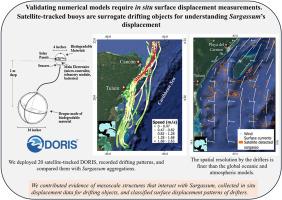Ocean drifters’ displacement compared to Sargassum spp. distribution in the Mexican Caribbean
IF 2.6
3区 地球科学
Q1 MARINE & FRESHWATER BIOLOGY
引用次数: 0
Abstract
Given the impacts of Sargassum spp. fluxes on the environment and society, there is a need to better understand the cover and displacement dynamics of this macroalgae at a local scale. The advances in telemetry and remote sensing technologies allow us to integrally assess the association between Sargassum coverage and the ocean surface movements at scales of tens to hundreds of kilometers. This study aimed to synthesize the displacement patterns of surface drifters and evaluate their association with historical patterns (2014–2020) of satellite-detected Sargassum coverage. Between 2019 and 2021, we deployed 20 satellite-tracked drifters (known as DORIS) in the southern Mexican Caribbean. Using multivariate tools, we assessed an overall residency time spatial index based on their surface displacement patterns and evaluated their spatial configuration. We compared the historic satellite-detected Sargassum coverages with the DORIS displacement patterns. The drifters depicted close-to-shore coherent shape displacement patterns and fast offshore streaming displacement. The region between southern Cozumel and Tulum exhibited the slowest DORIS displacement and, consequently, the longest residency time in the region, coinciding with the area where the satellite-detected Sargassum presence was characterized by high recurrence and intense, frequent episodes. These results enhance our understanding of a local oceanic recirculation area in the Mexican Caribbean, while also strengthening Mexico's technological capabilities for procuring resilient oceans and the essential conditions necessary for sustaining the livelihoods of local coastal communities.

海洋漂流者的位移与墨西哥加勒比海马尾藻分布的比较
考虑到马尾藻通量对环境和社会的影响,有必要更好地了解这种大型藻类在局部尺度上的覆盖和位移动态。遥测和遥感技术的进步使我们能够在数十至数百公里的尺度上综合评估马尾藻覆盖范围与海洋表面运动之间的关系。本研究旨在综合地表漂浮物的位移模式,并评估其与卫星探测马尾藻覆盖的历史模式(2014-2020年)的相关性。2019年至2021年期间,我们在墨西哥加勒比海南部部署了20艘卫星跟踪漂流船(称为DORIS)。利用多变量工具,我们评估了基于地表位移模式的总体居住时间空间指数,并评估了它们的空间配置。我们将卫星探测到的马尾藻覆盖率与DORIS的位移模式进行了比较。漂体表现出近岸连贯形状位移模式和近海快速流位移模式。Cozumel南部和Tulum之间的区域显示出最慢的DORIS位移,因此在该区域停留时间最长,与卫星检测到马尾藻存在的高复发和强烈频繁发作的区域相一致。这些结果增强了我们对墨西哥加勒比地区当地海洋再循环区域的了解,同时也加强了墨西哥获得弹性海洋的技术能力和维持当地沿海社区生计所需的基本条件。
本文章由计算机程序翻译,如有差异,请以英文原文为准。
求助全文
约1分钟内获得全文
求助全文
来源期刊
CiteScore
5.60
自引率
7.10%
发文量
374
审稿时长
9 months
期刊介绍:
Estuarine, Coastal and Shelf Science is an international multidisciplinary journal devoted to the analysis of saline water phenomena ranging from the outer edge of the continental shelf to the upper limits of the tidal zone. The journal provides a unique forum, unifying the multidisciplinary approaches to the study of the oceanography of estuaries, coastal zones, and continental shelf seas. It features original research papers, review papers and short communications treating such disciplines as zoology, botany, geology, sedimentology, physical oceanography.

 求助内容:
求助内容: 应助结果提醒方式:
应助结果提醒方式:


